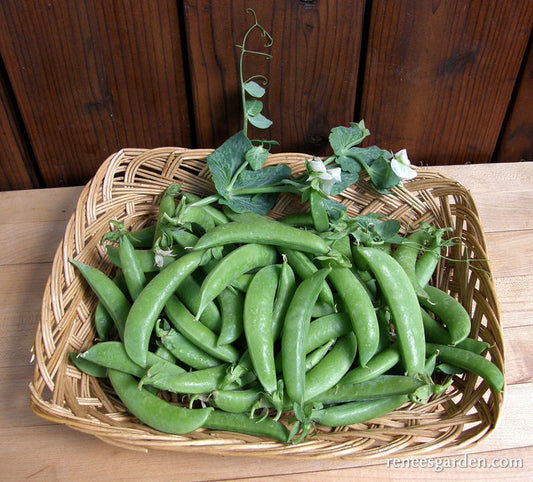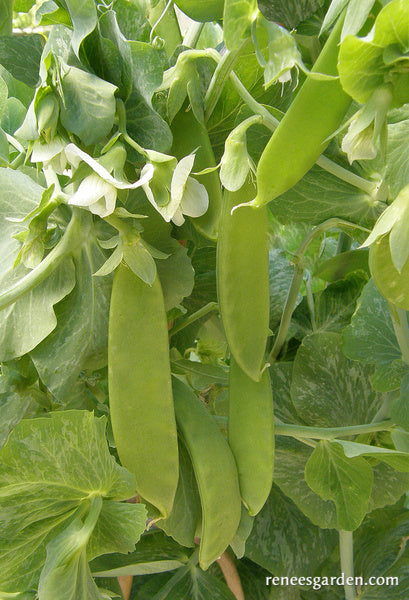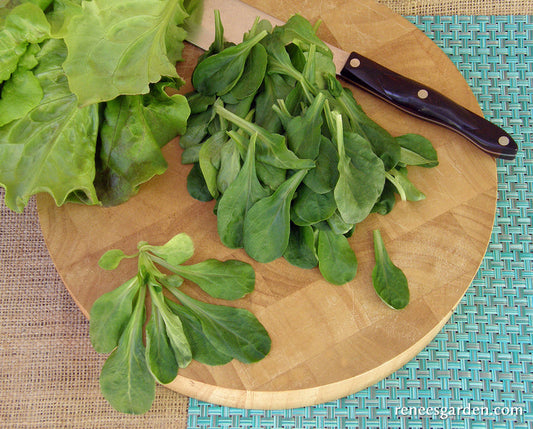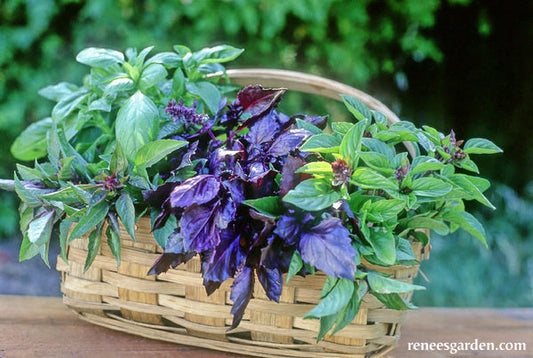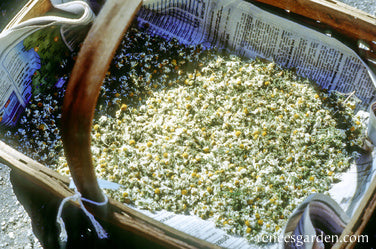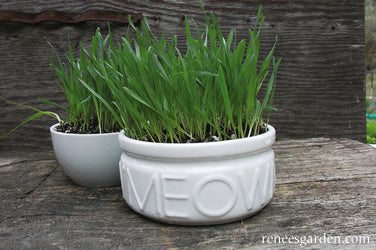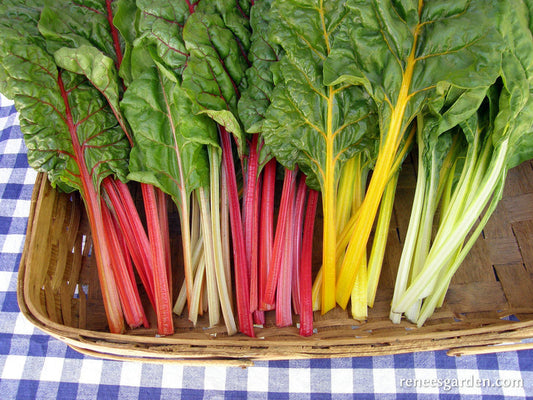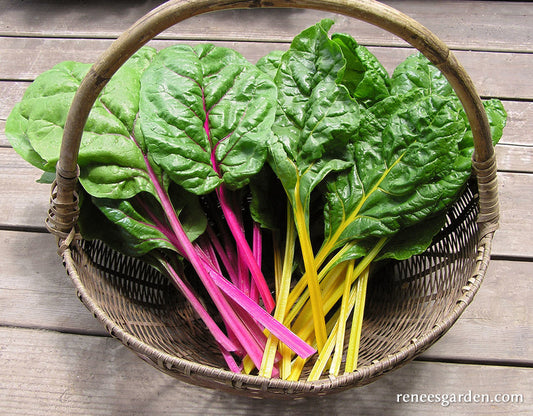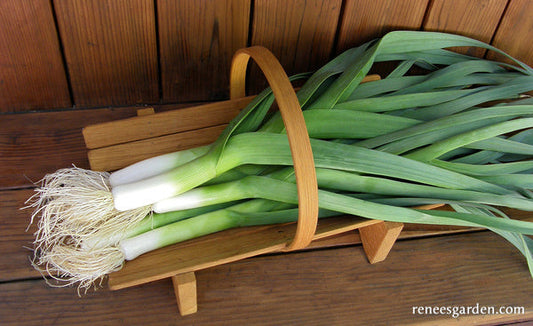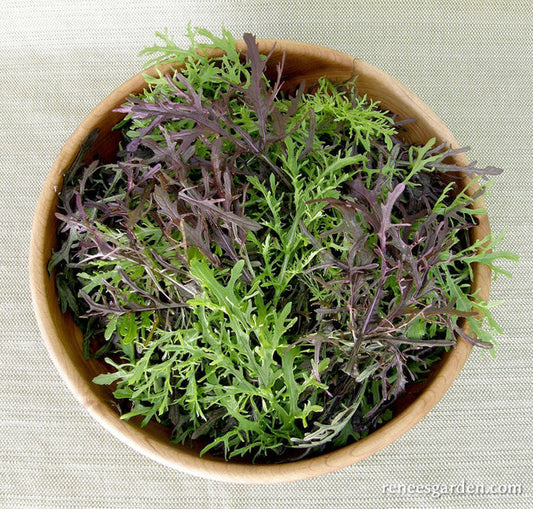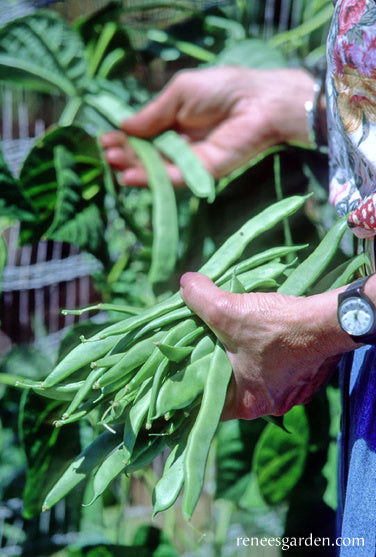Heirloom Selection
Heirloom Selections
-
Poppy Legion of Honor
(Papaver rhoeas) Elegant cup-shaped, crimson-colored single blossoms glow in the sun. Easy to grow in full sun, this beloved heirloom self-sows easily to bloom generously every year.Regular price $1.99Sale price $1.99Unit price / perNew -
Snap Peas Sugar Daddy
START SEEDS OUTDOORS
In early to mid-spring, plant peas in full sun in well-worked, fertile soil. Sow seeds 1 inch deep and 2 to 3 inches apart in wide rows or bands 3 inches across, spacing the wide rows 2 feet apart. Provide supports for these 2 1/2 to 3 foot vines at planting time. Protect from marauding birds with netting or floating row covers if necessary. Wet and cold early spring weather may affect germination so if first sowing doesn’t germinate evenly, replant right away as new seedlings catch up quickly. Sow again for a fall crop about 2 1/2 months before first expected fall frost.HARVEST AND USE
Harvest only when peas are mature and round in the thick walled, juicy pods for the best developed flavor. Savor their sweet crunch fresh from the garden (kids especially love them!) as a snack or slice into salads. To cook quickly, sauté in a little oil just until pods turn a deeper green color.GROWING NOTES
Use netting or wire trellis to support these heavy bearing vines for easy picking. Turn a sprinkling of bone meal and wood ashes into the soil before planting. Keep pea vines well weeded and watered and mulch to conserve moisture. Water at the base of the plants to avoid mildew.
Regular price $4.89Sale price $4.89Unit price / per -
Edible Pod Snow Peas Oregon Giant
START SEEDS OUTDOORS
In early spring, as soon as soil can be worked, plant peas in full sun in well-worked, fertile soil. Sow seeds 1 inch deep and 2 to 3 inches apart. Sow seeds in wide rows or bands 3 inches across, spacing the wide rows 2 feet apart. Provide supports for these 2 1/2-3 foot vines at planting time. Protect from marauding birds with netting or floating row covers if necessary. If first sowing doesn’t germinate evenly, replant right away as new seedlings catch up quickly. Sow again for a fall crop about 2 1/2 months before first expected fall frost.
GROWING NOTES
Use netting or wire trellis or short tree branches stuck into the ground to support these heavy bearing vines for easy picking. Turn a sprinkling of bone meal and wood ashes into the soil before planting. Keep pea vines well weeded and watered, and mulch to conserve moisture.
HARVEST AND USE
Pick frequently when pods are fully formed but still flat with tiny immature peas. Snow peas are delicious in stirfries with ginger, soy sauce and garlic. Cook very quickly, just until pods turn a deeper green color. Or simply enjoy the juicy pods fresh off the vines.Regular price $2.99Sale price $2.99Unit price / per -
Specialty Salads Gala Mâche
ANNUAL
Spring harvest
Frost hardyEASIEST TO START OUTDOORS
Mâche grows best sown in cooler weather to provide late fall and/or early spring salads. It tolerates light frosts well. In Cold Winter Areas, plant in mid-August for a fall crop or as early in spring as ground can be worked. In Mild Winter Areas, late summer/early fall planted mache will overwinter to fill the first spring salad bowls.
Sow seed 1/4 inch deep and 1 inch apart in rows 6 to 8 inches apart or broadcast thinly for bed planting. Seeds germinate slowly and unevenly over 14 to 28 days. Keep seed bed evenly moist during germination. Thin seedlings 3 inches apart when plants are large enough to handle. Keep well weeded and protect from slugs and snails.
GROWING NOTES
Mâche grows more slowly than lettuce, taking up to 3 months to fully mature. It needs a good supply of moisture, regular weeding, and does best in cool weather. When ready for harvest, each mature plant forms a rosette of leaves that measures three to five inches across. Harvest by cutting entire leafy rosettes. Leave some plants to go to seed as they will self-sow readily. Enjoy its delicate texture and nutty flavor with a simple vinaigrette dressing made with walnut oil or good olive oil.Regular price $3.69Sale price $3.69Unit price / per -
Kitchen Herbs Scented Basil Trio
ANNUAL
Summer/fall harvest
Heat-loving, frost tenderTO PLANT DIRECTLY INTO THE GARDEN
When late spring weather has reached the 55°F (13°C), sow seeds 1 inch apart in well worked fertile soil in full sun. Cover 1/2 inch deep, firm soil and keep seed bed moist. Germination takes 1 to 2 weeks. After seedlings are well established, thin or transplant 8 inches apart to allow plants room to mature.
TO START EARLY INDOORS
Sow seeds 1 inch apart in a container of seed starting mix, 4 to 6 weeks before last expected frost. Keep warm and evenly moist, and provide a good light source. When seedlings are large enough to handle and weather is above 55°F (13°C), acclimate gradually to the outdoors, then plant in the garden or into large pots.
GROWING NOTES
Remember—for success with this easy to grow herb, it is critical to sow or transplant basil into garden beds only when late spring day and night temperatures stay above 55°F (13°C). Harvest sprays of leaves by snipping stems just above two new sprouting lateral branches to encourage lush foliage. Keep flower buds pinched off to extend harvesting and feed regularly to promote new growth.Regular price $3.69Sale price $3.69Unit price / per -
Flowering Herbs Bodegold Chamomile
ANNUAL
Spring/summer/fall harvest
Frost hardyTO START DIRECTLY IN THE GARDEN
Sow seeds as thinly as possible in a well-drained, finely textured garden bed in full sun and cover lightly. Keep evenly moist while awaiting germination. Thin seedlings to 4 inches apart before they become crowded.
TO START INDOORS
Sow seeds in early spring in a container of seed starting mix. Cover seeds very lightly and keep evenly moist until seedlings emerge. Provide a good light source until seedlings are about 2 inches tall. Transplant 4 inches apart after gradually acclimating to outdoor conditions. Don’t let seedlings get too big or crowded before planting out.
GROWING NOTES
Start chamomile in early spring for sturdy growth before warm weather initiates flowering. Harvest every few days just as the petite daisylike flowers are fully open, but before the petals dry up. Air dry blossoms indoors in a single layer for several days, then store in a sealed container. Steep in boiling water for a lovely scented tea. Leave a few flowers in the garden to set seed, then shake spent plants and they will often self-sow to bloom next season. blossoms with their dainty white petals and gold centers and simply air dry for making fragrant pineapple-scented tea. Serve with a little honey to settle the stomach and soothe the nervous system before retiring.Regular price $2.99Sale price $2.99Unit price / per -
Container Cat Treats Gourmet Mixed Greens
ANNUAL CEREAL GRASSES
Oat, rye, wheat, barley
FOR BEST RESULTS
Fill a 6 inch diameter or larger, pot with moistened planting mix. Sprinkle seeds 1/4 inch apart over the surface, cover 1/2 inch deep with mix, and water gently. Keep pot moist but not soggy, and be sure to provide a good light source. The pot of grasses can be kept indoors for pets to graze on at their leisure. Fertilize every 2 weeks using a non-chemical fertilizer, such as fish emulsion.
GROWING NOTES
Our ample packet provides enough seed for 3 to 4 sowings. The grasses are ready for pets to nibble when the blades are at least a few inches tall, normally in about 10-14 days after sowing. If grasses get too tall and fall over, “mow” them down to 3-4 inches with a pair of scissors. For a constant supply, try sowing a pot every 2 weeks. Give your pet access to only one pot of grass at a time, and switch pots each week. When grass does not re-grow vigorously after cutting down and fertilizing, discard and start again with new seed and soil mix.
DINING IDEAS
Most cats will recognize the grass as a treat right away. To encourage finicky eaters, place the pot beside the kitty’s food and spritz it with water. This usually does the trick and cats who newly discover this treat delight in it!
Regular price $2.99Sale price $2.99Unit price / per -
Rainbow Chard Bright Lights
START SEEDS OUTDOORS
In early spring when danger of hard frost is over, sow seeds in well-worked, fertile soil in full sun. Sow seeds 1/2 inch deep and 1 inch apart in rows 10 inches apart, or broadcast thinly for bed planting. Firm soil well over these irregularly shaped seeds to ensure good germination. If first sowing germinates unevenly, plant more seed in the rows as seedlings catch up quickly. Thin to select colors beginning when seedlings are large enough to handle, using thinnings as early greens and salads. Final spacing should be 10 to 12 inches apart so chard plants have room to mature.
GROWING NOTES
Chard grows well in a wide range of conditions and can take some frost. In mild winter areas, it can be grown year round. Thin seedlings well as chard grows into large vase-shaped plants 2 feet tall.
HARVEST AND USE
Begin harvesting when plants are well established and have 6 to 8 stalks. Both the crunchy succulent stalks and leaves make great eating. Chop and steam or sauté greens with garlic and olive oil or season with fresh lemon juice or balsamic vinegar. Use like spinach in lasagna or minestrone soup. Try tasty chard leaves stuffed and poached in broth with a dash of olive oil and fresh lemon.
Regular price $4.99Sale price $4.99Unit price / per -
Rainbow Chard Neon Glow
START SEEDS INDOORS
In early spring, when danger of frost is over, sow seeds in well-worked, fertile soil in full sun. Sow seeds 1/2 inch deep and 2 inches apart in rows 10 inches apart, or broadcast thinly for bed planting. Firm soil well over these irregularly shaped seeds to ensure good germination. If first sowing germinates unevenly, plant more seed as seedlings catch up quickly. When large enough to handle, thin seedlings to final spacing of 8 to 10 inches apart so these large plants have room to grow and mature. Transplant extras or enjoy young thinnings as early greens and salads.
GROWING NOTES
Chard grows well in a wide range of conditions and can take some light frost. In mild winter areas, it can be grown year round. Give seedlings enough room, because chard grows into large vase-shaped plants 2 feet tall.
HARVEST AND USE
Begin harvesting when plants are well established and have at least 6 to 8 leaves. Both stalks and leaves make great eating. Chop and steam or sauté with garlic and olive oil. Use like spinach in lasagna or minestrone soup. Try tasty chard leaves stuffed and poached in broth with a dash of olive oil and fresh lemon.
Regular price $3.39Sale price $3.39Unit price / per -
German Leeks Striesen
BEST TO START INDOORS
Sow seeds 1 inch apart in a container of seed starting mix, cover 1/2 inch deep, and firm soil over seeds. Keep moist and provide a strong light source until seedlings are ready to plant out. Seeds germinate sporadically over 2 to 3 weeks and grow slowly at first. Once seedlings are 3 or 4 inches tall, transplant 4 to 6 inches apart into well-worked, fertile soil in full sun. To get long-shanked leeks, plant seedlings down deep into the soil, so tips stick up 2 inches above ground level.
TO START OUTDOORS
Sow seeds in well-worked, fertile soil in full sun. Space seeds 1 inch apart in rows 8 to 10 inches apart, or broadcast thinly for bed planting. Cover 1/2 inch deep and firm soil well over seeds; keep soil moist to ensure good germination. Thin as above.
GROWING NOTES
Plant leeks in early spring and again in midsummer for fall and winter use. Long-growing leeks need a rich fertile soil, so add lots of compost or aged manure before planting, and fertilize several times over the growing season. Weed leeks carefully when young, and mulch to conserve soil moisture.
HARVEST AND USE
Harvest as slim babies to steam whole or quickly grill. Let some leeks mature to full size and dig as needed with a garden fork. Mature leeks store well in the ground during the winter months. Use in cooking like sweet onions, or as a tasty vegetable side dish.
Regular price $4.89Sale price $4.89Unit price / per -
Colorful Salad Mustards Ruby & Emerald Streaks
START SEEDS OUTDOORS
In cool early spring weather, sow seeds in finely-worked soil in full sun. Shake seeds from the palm of your hand, broadcasting them about 1/2 inch apart over the entire seedbed or in wide rows, and cover lightly and evenly with 1/4 inch of fine soil. Firm soil gently and water with a fine spray. Keep seedbed evenly moist. Make small successive sowings until summer weather turns hot for a constant supply. Plant again in late summer for fall harvesting.
GROWING NOTES
These feathery, lacy plants grow easily in cool weather with consistent moisture and will produce a fast leafy harvest. To extend the sowing season into hot weather, sow in light shade or erect a canopy of loosely woven shade cloth over the bed. Birds are often attracted to tender young seedlings, so protect them if necessary.
HARVEST AND USE
To harvest by the “cut and come again” method, wait until plants are 4 to 6 inches tall. Cut as much as you need, using scissors to shear off a patch of leaves about 1 to 2 inches above the soil level. Water well and fertilize lightly and plants will regrow for more cuttings before summer heat comes on. Enjoy Ruby Red and Emerald Green’s beautiful colors and delicious, mildly spicy mustard flavor in spring and fall salads, on cheese plates and add the pretty, savory leaves to sandwiches and Panini.
Regular price $4.89Sale price $4.89Unit price / per -
Pole Beans Early Spanish Musica
START SEEDS OUTDOORS
In spring once weather is warm and night temperatures stay securely above 55°F (13°C), plant seeds in well-worked, fertile soil in full sun. Erect strong stakes, tripod poles, or trellis at planting time to support vines. Plant seeds 1 inch deep and 4 inches apart along a trellis, or if planting around tripods or stakes, plant 4 to 6 seeds 4 inches from each pole, thinning seedlings to 3 best plants.
GROWING NOTES
Tender, crispy beans are an easy, reliable crop to grow, but don’t plant too early, as weather under 50°F (10°C) prevents good germination. If first sowing comes up unevenly, replant right away; new seedlings catch up quickly. Birds are often attracted to young bean seedlings, so watch carefully and protect with netting or floating row covers if necessary. Avoid cultivating plants or picking pods when plants are wet.
HARVEST AND USE
Musica vines are heavy bearing, so harvest often: the more you pick, the more beans plants will produce. Harvest when beans are 7-9 inches long, but before seeds are swelled in pods. Slice up and cook just until tender to enjoy their sweet nutty flavor and juicy texture. Serve hot, or let the cooked beans cool, then toss with herbed vinaigrette for a delicious green bean salad.
Regular price $4.89Sale price $4.89Unit price / per -
Hot Chile Peppers Scotch Bonnet
Bright red, lantern-shaped, superhot chiles that pack a real flavor punch for making salsas, hot sauces and Tex-Mex dishes. Plants are easy to grow and reliably bear heavy crops of fiery chiles.Regular price $2.49Sale price $2.49Unit price / per


